Briagolong (Br)
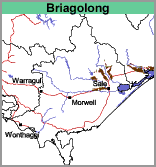
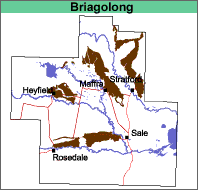
Geology
Alluvial sediments deposited in the Pleistocene period. Following the notation of Vandenberg and O’Shea (1981), these sediments are called Qp4 (refer to Diagrammatic Representations). These deposits often contain quartz stones up to 100 mm in diameter.
Landform
Level to very gently undulating plain.
An interactive visualisation of the landscape in Briagolong is provided. Zooming and panning functionality is provided as well as the ability to click on icons to provide further information about the landscape (e.g. soils, geology) as well as access other panoramas in the study area.
Photo
Panoroma
Information
Soil site
Video
NOTE: To leave panorama press 'Ctrl' and 'F5'.
Use your keyboard and mouse to navigate the study area. To zoom in or out, left mouse click inside the panorama and use the mouse's 'scroll wheel' (if you have one). To explore the landscape, click and hold the left mouse button on the landscape and move the mouse left, right, up or down or use 'cursor keys'.
Original Vegetation
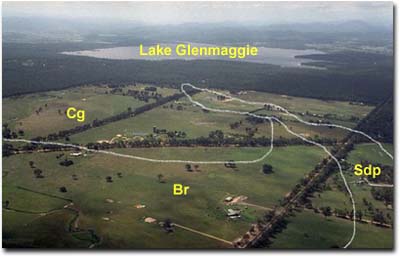
The original vegetation was a grassy open forest of red gum (Eucalyptus tereticornis). It has now largely been cleared.
This photo (facing north) shows the pattern of remaining vegetation and the overall near flat topography in this mapping unit.
Previous Maps and Reports
This map unit was identified and named by Ward (1977). It is included within both the Redgum 1 and Redgum 2 Land Systems as described by Aldrick et al. (1992). Skene and Walbran (1948, 1949) mapped all of the higher land into the Tanjil series and has been subdivided into the Briagolong and Stratford map units in this report.
Soils
Most of the soils on this map unit are texture contrast soils. This means that they have light textured surface soils (loamy sands to sandy loams) abruptly overlying the clay subsoil. Stones throughout the profile (up to 100 mm in diameter) are a common feature of many of the soils, particularly on hill slopes and the flanks of drainage lines.
The surface soils are generally dark greyish brown loamy sands to sandy loams. They have a bleached subsurface (typically pale brown to pale brownish grey) of similarly textured material abruptly overlying mottled brown and yellow clays at about 20 to 30 cm. Red mottles generally occur at depth. Clays or sandy clays normally continue to at least 1 m, often accompanied by gravel and stones. These soils are generally classified as Yellow or Brown Sodosols.
Chemical and Physical Analysis
Analysis for one pit on this map unit was examined (Site GP78) and can be viewed below. Detailed physical and chemical analysis for three other profiles within the Briagolong map unit are given by Aldrick et al. (1992) and Skene and Walbran (1948).
The surface pH’s of the soils are usually less than 6.0 and may be below 5.5. The pH’s in the clay subsoil are variable. Aldrick et al. (1992) found his profiles to have acidic subsoils less than pH 5.5. In comparison, Site GP78 became alkaline with depth. Exchangeable magnesium is the dominant cation in the subsoil and the ratio of calcium to magnesium decreases with depth. Generally the clay subsoils are also strongly sodic.
GP78. Soil Pit Site (Sargeant and Imhof, 2000)
| Depth cm | Texture | pH | EC dS/m | Cl % | Nitrogen % | Carbon % | Ca meq % | Mg meq % | K meq % | Na meq % | H meq% | ESP % | Gravel % | Coarse sand % | Fine sand % | Silt % | Clay % | LAT % |
| 0-10 | FSL | 5.1 | 0.32 | 0.17 | 2.5 | 3.1 | 1.1 | 0.5 | 0.1 | 23 | 46 | 18 | 9 | 2 | ||||
| 10-25 | SL&GR | 5.4 | 0.13 | 0.7 | 0.4 | 0.5 | 0.3 | 27 | 48 | 17 | 7 | 1 | ||||||
| 25-50 | MC | 6.7 | 0.19 | 0.8 | 11 | 0.5 | 2.5 | 17 | 10 | 26 | 15 | 48 | 2 | |||||
| 60-80 | MC | 7.7 | 0.25 | 0.2 | 9.2 | 0.2 | 3.4 | 16 | 8 | 29 | 19 | 42 | 1 | |||||
| 80-130 | 8 | 0.25 | 0.2 | 8.5 | 0.2 | 3.5 | 29 | |||||||||||
| 130+ |
Profile 61, Red Gum 1,2, (Aldrick et al., 1992)
| Depth cm | Texture | pH | EC dS/m | Cl % | Nitrogen % | Carbon % | Ca meq % | Mg meq % | K meq % | Na meq % | H meq % | ESP % | Gravel % | Coarse sand % | Fine sand % | Silt % | Clay % | LAT % |
| 0-3 | SL | 5.9 | 0.21 | .018 | 0.76 | 11.6 | 11.0 | 4.4 | 0.8 | 0.6 | 14.2 | 2 | 1 | 19 | 33 | 13 | 15 | |
| 10-15 | LS | 5.3 | 0.04 | .004 | 0.043 | 0.54 | 0.3 | 0.9 | 0.06 | 0.3 | 6.4 | 4 | 3 | 20 | 39 | 18 | 12 | |
| 15-20 | MC | 5.3 | 0.07 | .005 | 0.063 | 0.58 | 0.2 | 4.8 | 0.2 | 1.5 | 12.5 | 8 | 3 | 20 | 26 | 12 | 40 | |
| 60-90 | HC | 4.7 | 0.27 | .031 | 0.1 | 4.4 | 0.2 | 3.4 | 9.7 | 19 | 1 | 23 | 27 | 6 | 42 | |||
| 90-120 | SC | 4.5 | 0.42 | .051 | 0.1 | 5.9 | 0.2 | 4.6 | 10.3 | 23 | 1 | 8 | 35 | 11 | 44 |
Tanjil gravelly sand, (Skene and Walbran, 1948)
| Depth cm | Texture | pH | EC dS/m | Cl % | Nitrogen % | Carbon % | Ca meq % | Mg meq % | K meq % | Na meq % | H meq % | ESP % | Gravel % | Coarse sand % | Fine sand % | Silt % | Clay % | LAT % |
| 0-8 | LS | 5.9 | 0.06 | .004 | 0.149 | 2.10 | 18 | 39 | 37 | 12 | 7 | <1 | ||||||
| 8-20 | S | 6.2 | 0.04 | .003 | 63 | 40 | 39 | 13 | 6 | 1 | ||||||||
| 20-33 | GRS | 6.6 | 0.03 | .003 | 63 | 45 | 35 | 11 | 6 | 2 | ||||||||
| 36-61 | HC | 7.1 | 0.13 | .008 | 16 | 7 | 6 | 4 | 76 | 1 | ||||||||
| 61-109 | GRC | 6.5 | 0.10 | .009 | 66 | 53 | 12 | 4 | 29 | <1 |
Tanjil sandy loam, (Skene and Walbran, 1948)
| Depth cm | Texture | pH | EC dS/m | Cl % | Nitrogen % | Carbon % | Ca meq % | Mg meq % | K meq % | Na meq % | H meq % | ESP % | Gravel % | Coarse sand % | Fine sand % | Silt % | Clay % | LAT % |
| 0-8 | SL | 6.9 | 0.12 | .007 | 0.144 | 2.00 | 5 | 31 | 46 | 15 | 8 | 1 | ||||||
| 8-18 | SL | 6.1 | 0.04 | .004 | 11 | 32 | 45 | 14 | 8 | 1 | ||||||||
| 18-30 | S | 6.3 | 0.05 | .006 | 46 | 36 | 43 | 15 | 7 | <1 | ||||||||
| 33-66 | HC | 6.3 | 0.38 | .041 | 1 | 7 | 8 | 3 | 74 | 1 | ||||||||
| 66-107 | HC | 7.9 | 0.37 | .049 | 8 | 20 | 18 | 5 | 53 | 1 | ||||||||
| 107-145 | MC | 8.2 | 0.47 | .064 | 2 | 22 | 20 | 4 | 50 | 1 |
The following abbreviations are used to describe field texture: S - sand; LS - loamy sand; ClS - clayey sand; SL - sandy loam; L - loam; CL - clay loam; SCL - sandy clay loam; SC - sandy clay; FSCL - fine sandy clay loam; FSC - fine sandy clay; LC - light clay; MC - medium clay; HC - heavy clay; GR - gravel; ZL - silty loam; ZCL - silty clay loam; ZLC - silty light clay; ZMC - silty medium clay.
Particle size distribution data given for Skene and Walbran (1948, 1949) does not include the water content of the soil. As a result the coarse sand, fine sand, silt, clay and loss on acid treatment (LAT) may not add up to 100%. Aldrick et al. (1992) does not provide LAT data.
Other symbols include: pH - analysed in water; EC - electrical conductivity; Cl - chloride; Ca - exchangeable calcium; Mg - exchangeable magnesium, K - exchangeable potassium; Na - exchangeable sodium; H - exchangeable hydrogen; ESP - exchangeable sodium percentage.
For Soil Pit Sites (Sargeant and Imhof, 2000) exchangeable cations have been determined using Gilman method (where pH >7) and Tucker method (pH <7). Exchangeable Sodium % (ESP) has been calculated here as the percentage of sodium in relation to the sum of the exchangeable basic cations.
Land Use
Most of the soils are cleared and used for grazing. Some cropping is carried out near Briagolong. During wetter periods of the year, the surface soils may become saturated as the subsoil clay restricts the downward movement of water.
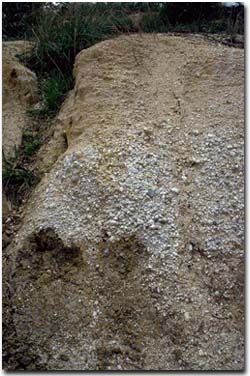
Gravel and stones in the deep subsoil within Briagolong mapping unit.
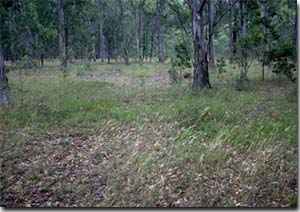
Red gum forest south of Briagolong. Note: weakly developed gilgai microrelief.


